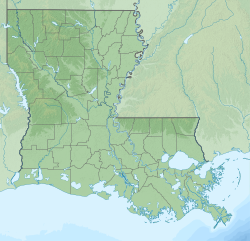
Back Cane River Creole National Historical Park CEB Cane River Creole National Historical Park French
Cane River Creole National Historical Park | |
 Tenant farmer log house in the Cane River Creole National Historical Park | |
| Location | 4386 Hwy 494, Natchez, Louisiana |
|---|---|
| Nearest city | Natchitoches |
| Coordinates | 31°39′56″N 93°00′10″W / 31.66556°N 93.00278°W |
| Area | 207 acres (84 ha) |
| Visitation | 26,996 (2011)[2] |
| Website | www |
| NRHP reference No. | 01000226[1] |
| Significant dates | |
| Added to NRHP | November 2, 1994 |
| Designated NHP | November 2, 1994 |
The Cane River Creole National Historical Park was established in 1994 to preserve the resources and cultural landscapes of the Cane River region in Natchitoches Parish, Louisiana. Located along Cane River Lake, the park is approximately 63 acres and includes two French Creole cotton plantations, Oakland and Magnolia. Both plantations are complete in their historic settings, including landscapes, outbuildings, structures, furnishings, and artifacts; and they are the most intact French Creole cotton plantations in the United States. In total, 65 historic structures and over a million artifacts enhance the National Park Service mission as it strives to tell the story of the evolution of plantation agriculture through the perspective of the land owners, enslaved workers, overseers, skilled workers, and tenant farmers who resided along the Cane River for over two hundred years. This park is included as a site on the Louisiana African American Heritage Trail.
A defining characteristic of the park is the conservation and interpretation of Creole culture. In colonial Louisiana the term "Creole" was used to indicate New World products derived from Old World stock, and could apply to people, architecture, or livestock. Regarding people, Creole historically referred to those born in Louisiana during the French and Spanish periods, regardless of their ethnicity. Today, as in the past, Creole transcends racial boundaries. It connects people to their colonial roots, be they descendants of European settlers, enslaved Africans, or the many of mixed heritage, which may include African, French, Spanish, and American Indian influences. The Prud'hommes of Oakland and the LeComtes of Magnolia were considered French Creole. As with others in the area, the homes and plantations of these families reflected the French Creole architectural style and way of life.
The historic landscapes and dozens of structures preserved at Oakland and Magnolia plantations are the setting for the stories of workers (enslaved and free) and late post-Civil War tenant farmers who worked the same land for over two centuries, adapting to historical, economic, social, and agricultural change. Today their descendants carry on many of their traditions.
- ^ "National Register Information System". National Register of Historic Places. National Park Service. November 2, 2013.
- ^ "National Park Service Visitor Use Statistics". National Park Service. Retrieved October 6, 2012.[permanent dead link]

